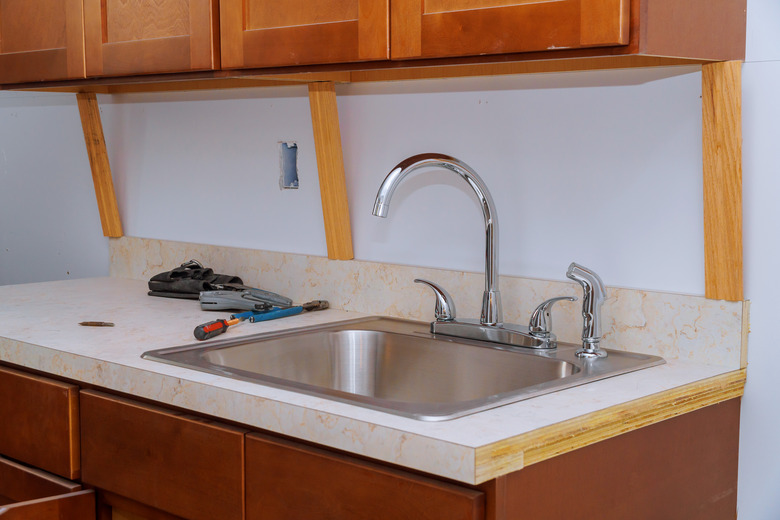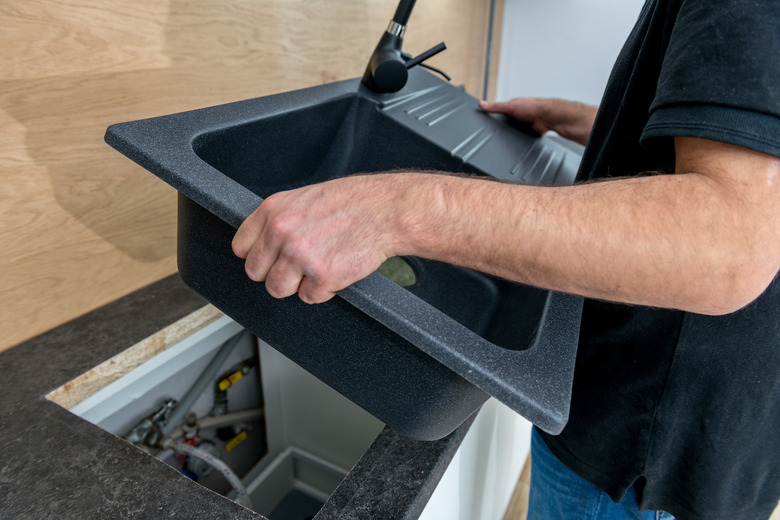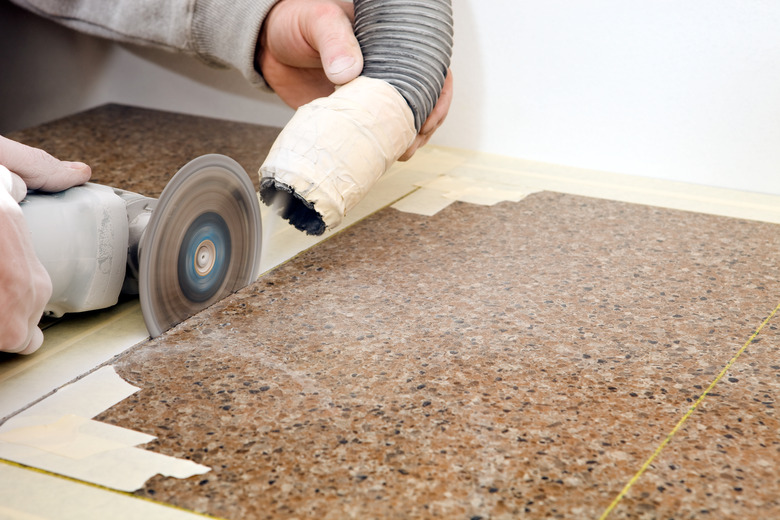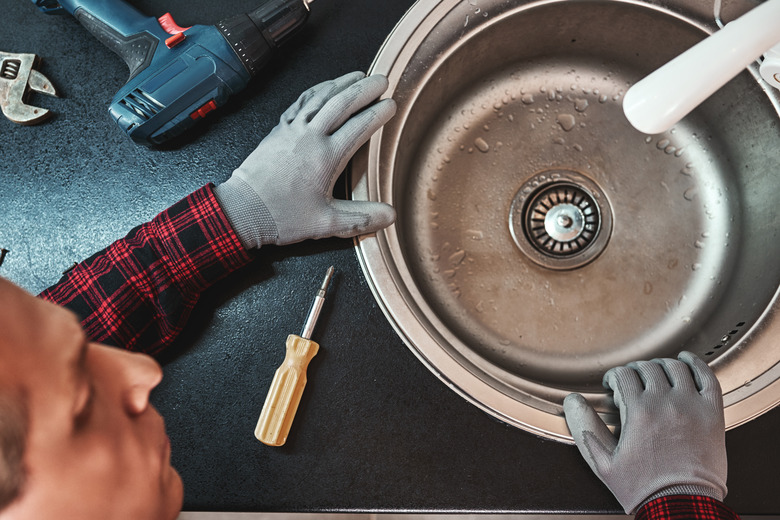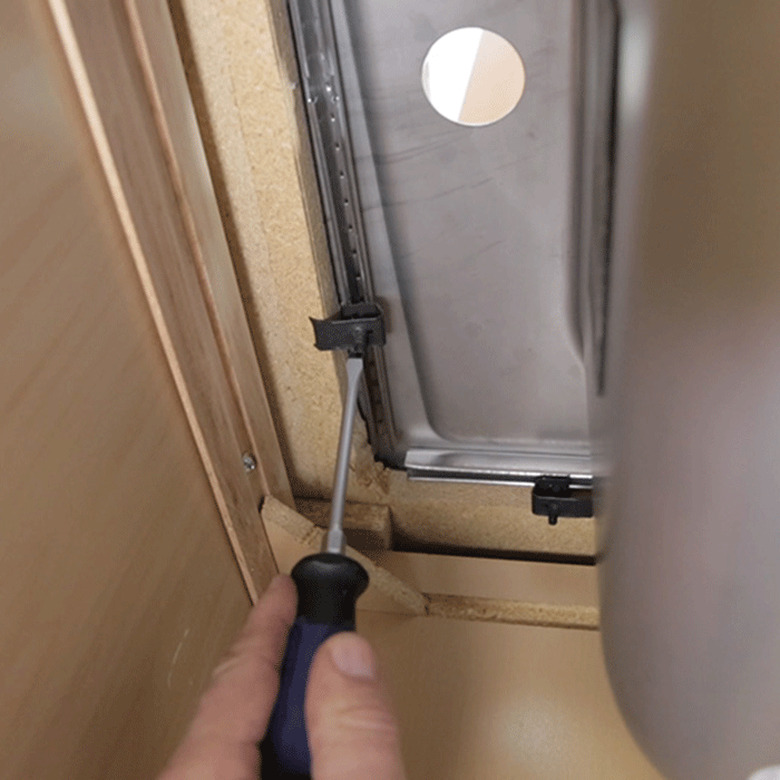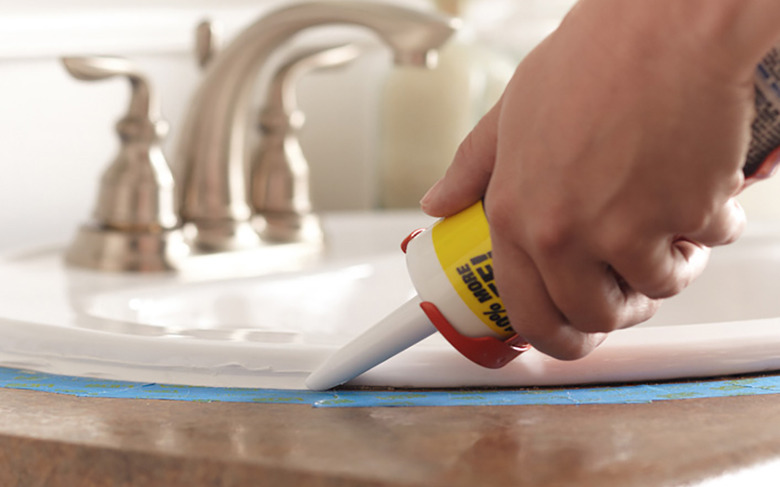How To Install A Drop-In Sink
Sinks are available in several different installation styles, and one of the most popular is the drop-in sink, sometimes known as a self-rimming sink. This style has a perimeter rim that sits on the surface of the countertop, and it is somtimes called a top-mount or over-mount sink to distinguish it from an under-mount sink that attaches to the underside of the countertop. Whatever you call it, a drop-in sink is relatively easy for DIYers to install, although it does involve attaching some plumbing components. The plumbing connections—mounting the faucet and installing the drain strainer—are much complete before you lower the sink into the countertop opening.
If the countertop doesn't have a precut hole to hold the sink basin you'll have to cut one, and the difficulty of this task varies, depending on the countertop material. Wood, laminate and cultured marble or solid surface countertops are relatively easy to cut with a jigsaw. But you'll need a grinder to cut stone or stainless steel, and the procedure requires considerable skill, so you might want consider hiring a pro to cut the hole if your countertop is made from one of these materials.
Read the Manual
Read the Manual
It pays to read the instructions that come with the sink before you begin installing it. The instructions describe how to use the enclosed clips to secure the sink to the counter, and these clips aren't the same for every model. The instructions also specify the shape and dimensions of the hole you need to cut into the counter, and they may include a template to make tracing the hole easier.
Tip
If you're replacing an old sink, you won't have to worry about cutting a hole, but you should clean the caulk carefully from around the existing hole. If you leave even a small amount, it will prevent the sink rim from resting flat on the countertop.
Installation Procedure
Installation Procedure
Things Needed
-
Pencil
-
Tape measure
-
Ruler
-
Jigsaw
-
Drill and twist bits
-
2 sawhorses
-
2 x 4s (20
-
Drain assembly
-
Plumber's putty
-
2 pairs of channel-lock pliers
-
Faucet
-
100 percent silicone caulk
-
Screwdriver
1. Draw the Cutout on the Countertop
Check the instructions for a cutting template. Sometimes it is printed on the sink's cardboard packing carton; other times it may be included as a paper template inside the carton. If there is a template, lay it out on the countertop, center it and draw the cutting line for the sink hole onto the countrop with a pencil. If the manual simply supplies dimensions, and the sink is square or some other regular shape, you can measure out the dimensions with a tape measure and draw the lines with a ruler and pencil.
If you don't have a manual or template, you can measure the dimensions yourself, but it's usually more accurate, especially with oval sinks, to place the sink upside-down on the countertop, center it and trace the outline of the rim. Remove the sink and trace a second outline inside the first outline. This outline should be inset by a distance equal to the measurement from the outside of the rim to the body of the sink.
Tip
The upside-down tracing method works for any sink whose shape is symmetrical from left to right and from top to bottom, which is most of them. If your sink has a non-symmetrical shape, draw its outline on a piece of cardboard, cut the shape out of the cardboard and place it on the counter to draw the sink outline. Then, draw a second outline to match the shape of the sink body, inset within the rim outline.
2. Cut the Hole for the Sink
Cut along the inner line with a jigsaw. To get the jigsaw started, drill a hole on the line large enough to allow you to insert the blade. Remove the cutout, lower the sink in the hole and make sure it sits flat on the countertop on all sides. If not, widen the hole as needed. Remove the sink when the hole is ready.
3. Attach the Drain Fittings
Set up a pair of 2 x 4s on two sawhorses and space them to support the sink from its rim. Set the sink on the 2 x 4s and attach the drain fitting:
- Roll some plumber's putty in your fingers to make a thin rope and wrap the rope around the underside of the drain strainer flange.
- Set the strainer body into the drain hole and push down to compress the putty onto the sink drain opening.
- Slide the rubber gasket and washer that came with the drain fitting onto the threaded end of the strainer from underneath the sink, then screw on the mounting nut and tighten it by hand.
- Hold the strainer body steady by inserting the handles of a pair of channel-lock pliers into the drain fitting from above. Then, use a second pair of channel-lock pliers to tighten the nut. Don't over-tighten or you could damage the sink. Wipe excess putty that has oozed out from under the strainer, using a rag.
If you're installing a garbage disposal, the process is similar to that for installing a drain fitting. Attach the disposal's coupler to the sink drain opening, following the installation instruction in the garbage disposal manual. The disposal itself is heavy, so it's best to wait until the sink is in place before attaching it to the coupler.
4. Install the Faucet
Insert the facet supply tubes through the holes in the sink deck and secure the faucet to the sink with the mounting nuts or mounting collar supplied with the faucet. Connect the sprayer if you're installing a kitchen sink. If you're dropping in a bathroom sink, this is a good time to connect the pop-up stopper assembly.
5. Set the Clips
Some sink model instructions call for installation of the holding clips before you drop the sink into the cutout. Check your installation manual to determine if this is true for your sink. If so, follow the instructions in the manual. The clips usually slide into place on a rail underneath the rim and must be spaced evenly around the sink.
6. Drop In the Sink
Spread a continuous bead of 100 percent silicone caulk around the perimeter of the cutout opening about 1/2 inch from the edge. Lower the sink into the cutout and push the rim down into the caulk to ensure a good bond.
7. Tighten the Clips
Install the clips, if you haven't done so already, and space them evenly around the sink. Using a screwdriver, tighten the screw on each clip, starting with the one in the front center, proceeding to the back center and then the center of each side. When these are secure, tighten the remaining clips.
Tip
Tighten the screws just enough to draw the rim down flush with the countertop, but no more. If you over-tighten the clips, you might chip out the underside of the countertop.
8. Spread Another Bead of Caulk
Wipe up any caulk that has oozed from under the rim of the sink, using a rag, then apply another bead to the edge of the rim and tool it with your finger. Make sure there are no gaps between the edge of the sink and the countertop. This second bead is insurance against dirt buildup and water seepage.
9. Connect the Faucet and Install the Drain Fittings
Hook up the faucet supply tubes to the shut-off valves under the sink, using flexible supply tubes. If the sink has a garbage disposal, clamp it into the coupling according to the installation instructions that came with the disposal. Hook up the P-trap assembly and connect it to the branch drain pipe.
Tip
The garbage disposal has to be plugged in or hardwired to power. Wait until all the plumbing work is complete and you've checked for leaks before doing this.
